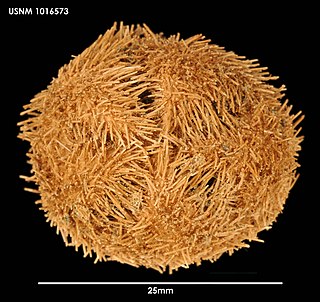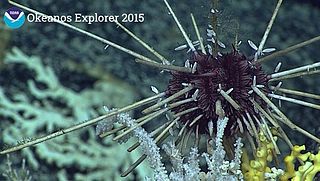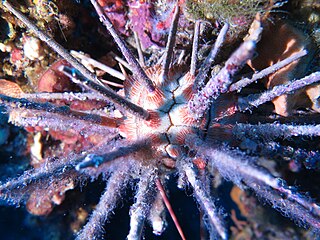
Astropecten is a genus of sea stars of the family Astropectinidae.

The Echinothurioida are an order of sea urchins in the class Echinoidea. Echinothurioids are distinguished from other sea urchins by the combination of a flexible test and hollow spines. The membrane around the mouth contains only simple plates, in contrast to the more complex mouth parts of their close relatives, the Diadematoida. They are nearly all deepsea dwellers.

Odontaster is a genus of sea stars. The type species is Odontaster hispidus.

Sterechinus is a genus of sea urchins in the family Echinidae. All living members of the genus are found in the waters around Antarctica but the first species described in the genus was a fossil and was found in Europe.
Amphipneustes bifidus is a species of sea urchin. Their armor is covered with spines. It is placed in the genus Amphipneustes and lives in the sea. Amphipneustes bifidus was first scientifically described in 1950 by Ole Mortensen, a Danish scientist.

Amphipneustes brevisternalis is a species of sea urchin. Their armour is covered with spines. It is placed in the genus Amphipneustes and lives in the sea. Amphipneustes brevisternalis was first scientifically described in 1926 by Koehler.

Amphipneustes koehleri is a species of sea urchin. Their armour is covered with spines. It is placed in the genus Amphipneustes and lives in the sea. Amphipneustes koehleri was first scientifically described in 1905 by Ole Mortensen.
Amphipneustes rostratus is a species of sea urchin. Their armour is covered with spines. It is placed in the genus Amphipneustes and lives in the sea. Amphipneustes rostratus was first scientifically described in 1926 by Koehler.

Amphipneustes similis is a species of sea urchin. Their armour is covered with spines. It is placed in the genus Amphipneustes and lives in the sea. Amphipneustes similis was first scientifically described in 1936 by Ole Mortensen, Danish zoologist.
Amphipneustes tumescens is a species of sea urchin. Their armour is covered with spines. It is placed in the genus Amphipneustes and lives in the sea. Amphipneustes tumescens was first scientifically described in 1926 by Koehler.
Anabrissus damesi is a species of sea urchin of the family Brissidae. Their armour is covered with spines. It is placed in the genus Anabrissus and lives in the sea. Anabrissus damesi was first scientifically described in 1881 by Alexander Agassiz, American scientist and engineer.

Clypeaster, common name "cake urchins" or "sea biscuits", is a genus of echinoderms belonging to the family Clypeasteridae.

The Echinothuriidae are a family of sea urchins in the order Echinothurioida. Due to their soft skeletons, most are called "leather urchins", but species in the genus Asthenosoma are also known as "fire urchins" due to their bright colors and painful, venomous sting.

Histocidaris is a genus of sea urchins in the family Histocidaridae. Some species are known from the fossil record.

The pourtalesiids (Pourtalesiidae) are a family of irregular sea urchins that live in the deep sea. They are secondarily bilateral-symmetrical and like other representatives of the taxon Holasteroida they lack the lantern of Aristotle, which is typical for many other sea urchins. The genus Pourtalesia was named after Louis-François de Pourtalès who first collected these animals while dredging at a depth of 600 m. The family is known already from the Upper Cretaceous (Maastrichtian) and is distributed worldwide.

Abatus is a genus of sea urchins belonging to the family Schizasteridae.

Stylocidaris is a genus of echinoderms belonging to the family Cidaridae.
Brissopsis is a genus of echinoderms belonging to the family Brissidae.

Ophiura is a genus of echinoderms belonging to the family Ophiuridae.

Notocidaris is a genus of echinoderms belonging to the family Ctenocidaridae.














